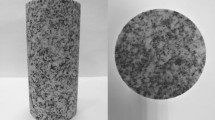Abstract
The use of the tension-softening model for analyzing fracture processes of rock is examined with special reference to the effect of confining pressure on the fracture extension. Tension-softening curves are measured by means of the J-based technique from unconfined tests performed on compact tension (CT) specimens of granite. On the basis of the determined tension-softening relation, numerical analyses are executed using a boundary element method (BEM) to simulate fracture of the granite under confining pressures. Numerical results are compared to the experimental results of two series of tests for which CT specimens and thick-walled cylindrical specimens were loaded to failure under confining pressures ranging from 0 to 26.5 MPa. It is shown that the BEM analyses can predict the observed fracture behavior. Based on the results, it is demonstrated that the tension-softening relation provides a suitable model to analyze the fracture process in the rock. The source mechanism for the pressure sensitive fracture is discussed by examining the growth of the fracture process zone.
Similar content being viewed by others
References
H. Abé, T. Mura and L.M. Keer, Journal of Geophysical Research 81(29) (1976) 5335–5340.
H. Takahashi and H. Abé, in Fracture Mechanics of Rock, B.K. Atkinson (ed.) Academic Press, London (1987) 241–276.
E.R. Simonson, A.S. Abou-Sayed and R.J. Clifton, Constrainment of massive hydraulic fracture. SPE Paper No. 6089, 51st Annual Fall Meeting of SPE of AIME (1976).
M. Thiercelin, International Journal of Rock Mechanics and Mining Sciences & Geomechanics Abstracts 26(3) (1989) 177–183.
T.K. Perkins and W.W. Krech, Society of Petroleum Engineers Journal 6 (1966) 308–314.
R.A. Schmidt and C.W. Huddle, International Journal of Rock Mechanics and Mining Sciences & Geomechanics Abstracts 14 (1977) 289–293.
A.S. Abou-Sayed, An experimental technique for measuring the fracture toughness of rock under downhole stress condition, VDI-Berichte 313 (1978) 819–824.
R. Kobayashi and N. Otsuka, Journal of the Mining and Metallurgical Institute of Japan 96(1114) (1980) 879–884, in Japanese.
M. Kosugi, Journal of the Mining and Metallurgical Institute of Japan 102(1182) (1986) 469–476, in Japanese.
M. Thiercelin, in Proceedings of 28th U.S. Symposium on Rock Mechanics (1987) 149–156.
A.R. Ingraffea, K.L. Gunsallus, J.F. Beech and P.P. Nelson, Chevron-Notched Specimens: Testing and Stress Analysis, J.H. Underwood, S.W. Freiman and F.I. Baretta (eds.), ASTM STP 855 (1984) 152–166.
H. Takahashi, in Fracture Toughness and Fracture Energy-Test Methods for Concrete and Rock, H. Mihashi, H. Takahashi and F.H. Wittmann (eds.), A.A. Balkema, Rotterdam (1989) 591–610.
R.A. Schmidt and H.P. Rossmanith, Rock Fracture Mechanics, H.P.Rossmanith (ed.), CISM Courses and Lectures No. 275, Springer-Verlag, Vienna (1983) 1–29.
J.F. Labuz, S.P. Shah and C.H. Dowding, International Journal of Rock Mechanics and Mining Sciences & Geomechanics Abstracts 24(4) (1987) 235–246.
A. Hillerborg, M. Modeer and P.E. Petersson, Cement and Concrete Research 6 (1976) 773–782.
A. Hillerborg, Fracture Mechanics of Concrete, F.H. Wittmann (ed.), Elsevier Science Publisher, B.V., Amsterdam (1983) 223–250.
V.C. Li, C.M. Chan and C. Leung, Cement and Concrete Research 17 (1987) 441–452.
E. Bruhwiler and F.H. Wittman, Engineering Fracture Mechanics 35(1/2/3) (1990) 117–125.
T. Hashida and H. Takahashi, Journal of Testing and Evaluation 13(1) (1985) 77–84.
C.F. Shih C, H.G. Delorenzi and W.R. Andrews, International Journal of Fracture 13 (1977) 544–548.
T. Hashida in Fracture Toughness and Fracture Energy-Test Methods for Concrete and Rock, H. Mihashi, H. Takahashi and F.H. Wittmann (eds.), A.A. Balkema, Rotterdam (1989) 47–55.
T. Hashida, in Proceedings of International Conference on Micromechanics of Failure of Quasi-Brittle Materials, S.P. Shah, S.E. Swartz, M.L. Wang (eds.), Elsevier Applied Science, London (1990) 233–243.
For example: W.F. Brace, State of Stress in the Earth's Crust, W.R. Judd (ed.), New York, Elsevier (1964) 111–174.
G. Wijk, Simple strength tests and hydraulic fracturing of rock material, Report DS 1982:10, Swedish Detonic Research Foundation (SveDeFo), Stockholm, Sweden (1982).
D.R. Schmitt and M.D. Zoback, in Proceedings of 2nd International Workshop on Hydraulic Fracturing Stress Measurements 1 (1988) 425–450.
P.L. Swanson, Journal of Geophysical Research 92 (1987) 8015–8036.
F. Ouchterlony, SM Archives 7 (1982) 131–211.
B.K. Atkinson and P.G. Meredith, Fracture Mechanics of Rock, B.K.Atkinson (ed.), Academic Press, London (1987) 477–525.
Author information
Authors and Affiliations
Rights and permissions
About this article
Cite this article
Hashida, T., Oghikubo, H., Takahashi, H. et al. Numerical simulation with experimental verification of the fracture behavior in granite under confining pressures based on the tension-softening model. Int J Fract 59, 227–244 (1993). https://doi.org/10.1007/BF00012363
Received:
Accepted:
Issue Date:
DOI: https://doi.org/10.1007/BF00012363



